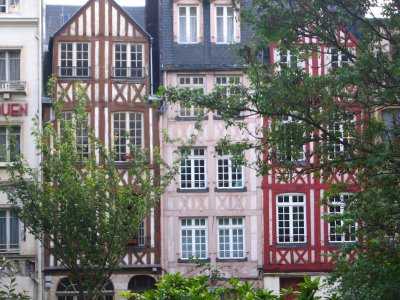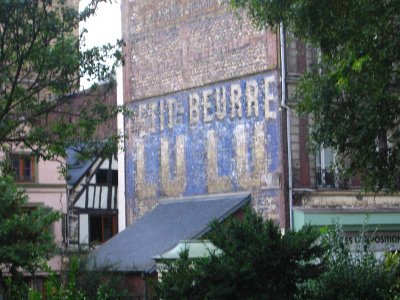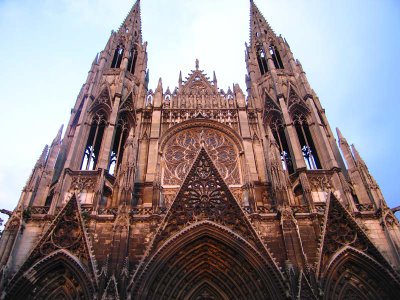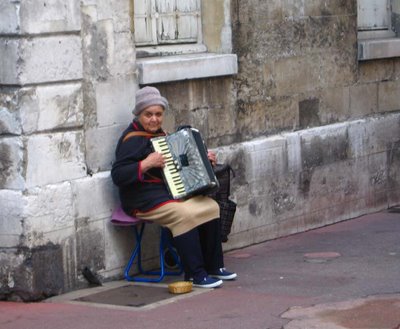Ten years ago, when Walt and I came to live in France, we arrived at the airport and drove directly up to Rouen, in Normandy, to spend a few days with friends there. They lived in the center of town near the old marketplace and the cathedral, and they had a studio apartment they let us stay in. The pictures in this post are ones I took on June 3, 2003. It was my second stay in Rouen that year. I've been posting about the first one for a few days now.
You can click on the pictures to see them at a larger size.
In 2003, the great Canicule — the deadly European heatwave — had already started, but we didn't know it yet. The Normandy climate is essentially damp and cool, but by early June ten years ago the weather was already hot and strangely sunny, even in Rouen.
 Buildings around Rouen's Vieux Marché — the old market square.
Buildings around Rouen's Vieux Marché — the old market square.The one in the middle all decked out in red flowers is La Couronne,
the restaurant where Julia Child had her first meal in France.
The reason we were in Rouen was that our friends who gave us use of the studio apartment were going to lend us some sheets, towels, and other essentials that we could take with us to Saint-Aignan, where we would move into an otherwise empty house. Those things would tide us over until our container of furniture and other possessions arrived in July — we had shipped it from California a month earlier.
Rouen is a magnificent old city with one of the most impressive cathedrals in France, two other fine churches, and the old tower where Joan of Arc was supposedly held prisoner before she was burned at the stake in the city's old marketplace in 1431. Historically, Rouen was considered the capital of Normandy. Victor Hugo called it « la ville aux cent clochers » — the city of 100 church towers. The novelist Stendhal called Rouen “the Athens of the Gothic era” for its great architectural treasures.
The historic center of Rouen is on the right bank of the Seine. On the left bank is a newer urban area, and the whole metropolitan area has a population of half a million. There's a new tramway that runs underground through the old part of the city. Rouen less than 90 minutes from Paris by train.
Here's a view of Rouen from a high viewpoint on the edge of the city. The cathedral is in the
middle of the picture with the Seine on the left and the Église St-Maclou on the right.
middle of the picture with the Seine on the left and the Église St-Maclou on the right.
I haven't spent nearly as much time in Rouen over the past ten years, since moving to Saint-Aignan, as I did back in the 1990s. Walt and I went to Rouen to visit other friends there in August 2006 — I posted about it here. A few years ago I did a series of four topics about Rouen and the time I spent there in the early 1970s. It starts here, and there's a link at the bottom of each topic to take you to the next one. And CHM and I made a quick stop in the city a couple of summers ago, posted here.





















































